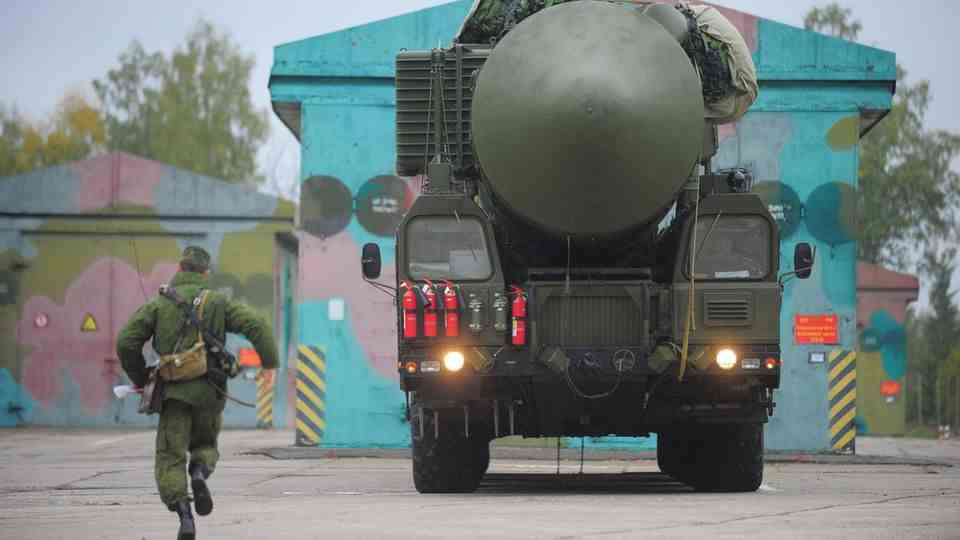Ukraine war
Three scenarios in which Russia could use nuclear bombs
In mid-April, Russia tested a nuclear-capable Sarmat-type ICBM.
© Roscosmos Space Agency Press Service/AP/DPA
Russia has scarcely disguised the threat of a nuclear bomb; the danger of using nuclear weapons has not been so high for 30 years. But why should the Kremlin boss do that at all? And under what circumstances could he? Three conceivable scenarios.
The atomic bomb is already unfolding its full power without even having to be used. Merely mentioning them or announcing that delivery systems will be put on alert spread fear and terror. That’s what Russian President Vladimir Putin did recently. He had previously threatened “unprecedented consequences” if “the West intervened in the Ukraine war.” That there could be more behind it than mere rhetoric can be observed on Russian state television. “During prime time there is talk of sending atomic bombs to European cities,” says Pussy Riot’s Maria Alyokhina, who had fled the opposition. Graphics show how long Russian nuclear missiles need from Kaliningrad to Berlin, for example (106 seconds).
Since the Cold War, Europe has once again been in real danger of a nuclear strike. How high it actually is is debatable. Some rate it higher than at the time of the Cuban Missile Crisis, one of the most delicate moments in the superpower showdown at the time. The American secret services, on the other hand, believe that the use of nuclear weapons is unlikely.
The US magazine “Politico” points out that there are at least three variantsto use nuclear weapons. And not every one of them necessarily has to end in ultimate annihilation:
Scenario 1: The atomic bomb test
This use of nuclear weapons would be more symbolic, but disturbing nonetheless: the above-ground test of a low-yield nuclear bomb. For example on the island of Novaya Zemlya, a remote test site in the Arctic Ocean. The damage to be expected and the fallout would be negligible there, but not the psychological effect. It would be the first nuclear weapon detonation by a superpower since 1992 and the first atmospheric test since 1963. It would also be “a powerful reminder that Putin has tactical nuclear weapons in abundance, around 2,000, and is prepared to use them,” Politico said “.
Scenario 2: An explosion in the airspace over Ukraine
In 1962, the USA detonated a nuclear warhead 400 kilometers above the Pacific Ocean – with surprising results. The electromagnetic impulse paralyzed the street lighting and the telephone system on the Hawaiian Islands 1500 kilometers away. A comparable nuclear explosion over Ukraine would be visible from afar and could envelop entire regions in “darkness and silence, turning off computers, cell phones and other electronics,” writes the US magazine. However, the same effect could occur both in NATO countries and in Russia. The consequences of this scenario are therefore also difficult to assess for the Kremlin.
Selfies from trenches, children in tanks: Putin’s propaganda uses history as a weapon
18 images
Scenario 3: use of atomic bombs in Ukraine
The most dangerous and therefore probably the least likely use would be the bombardment of Ukrainian targets, for example military installations or cities like Mariupol, with nuclear warheads. Airdrops over sparsely populated areas such as farmland in the west of the country would also be conceivable. But even the smallest atomic bomb would set large swaths of land on fire. And depending on the height of the explosion, the radioactive fallout could move towards NATO countries as well as towards Russia.
Conclusion: “Although these scenarios are currently unlikely, they are not far-fetched either, because there are conceivable reasons: an imminent defeat for Russia, further humiliation such as the loss of the Russian flagship “Moskva” or growing domestic Russian dissatisfaction with the course of the war – Putin needs no logical reason for the use of nuclear weapons,” according to Politico.
Sources: DPA, AFP, “Politico”


